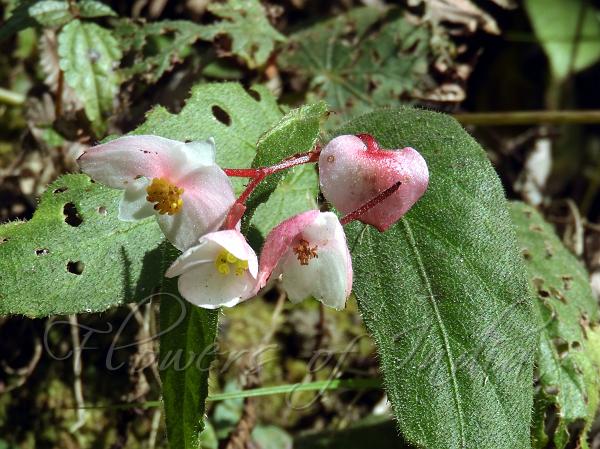|
| East-Himalayan Begonia |
|

|

| File size | 1037738 |
| Original date | 2/3/20 1:12 PM |
| Resolution | 5184 x 3888 |
| Flash | Flash did not fire, auto, red-eye reduction |
| Focal length | 20.6mm |
| Exposure time | 1/400s |
| Aperture | 5.0 |
| Focus Distance | |
| Metering Mode | Multi-segment |
| Camera make | NIKON |
| Camera model | COOLPIX B700 |
| Sensor type |
|
|
|
|
Photo: |
Botanical name: Begonia griffithiana Family: Begoniaceae (Begonia family)
Synonyms: Begonia episcopalis, Mezierea griffithiana
Synonyms: Begonia episcopalis, Mezierea griffithiana
East-Himalayan Begonia is an erect or cascading, herb,
50-100 cm tall. Stem is slightly woody, stout at the base. Stipules:
are lanceshaped, 4-13 x 1-2 mm. Leaf-stalk is 0.2 1 cm long, woolly;
blade oblong-lanceshaped to lanceshaped, basifixed, base shallowly
heart-shaped, 5-18 x 2-5 cm, strongly asymmetric, upper surface green,
sparsely hairy to hairless, underside green, margin minutely toothed or
with small teeth at ends of the main veins only, tip tapering. Flowers
are borne in numerous-flowred cymes in leaf-axils or at branch-ends,
carried on flower-cluster-stalk hairless, branching 2-3 times, primary
3-5 cm, secondary 2-4 cm, tertiary 1-1.5 cm, with 2-4 female and 4-8
male flowers. Male flower-stalks are 6-10 mm long, tepals 4; outer
tepals round to oblong, 4-14 x 2-11 mm, pale pink to white, hairless,
inner tepals lanceshaped to linear, 3-9 x 1-4 mm, pale pink, hairless;
androecium with 20-30 stamens, filaments 1-2 mm long. , unequal, fused
at base into a column. Female flower-stalks are 1.0-1.5 cm long, tepals
5-6, equal, 3-4 larger and 1-2 smaller, oblong elliptic to
obovate-round, outer tepals 6-11 x 5-7 mm, pale pink to white,
hairless, inner tepals similar but smaller. Ovary capsule is
oblong-ellipsoid, 5-7 x 2-3 mm, pink, hairless, with one long
triangular wing; styles 2, convoluted with slightly twisted ends,
deciduous. Fruit is drooping; capsule oblong-ellipsoid, 14-18 x 4-6 mm,
red, wing extending along the flower-stalk slightly, unequal, rounded
triangle, 1.2-1.8 x 1.4-1.8 cm. East-Himalayan Begonia is found in Ne
India, from Arunachal Pradesh to Meghalaya, also in Bhutan and Myanmar,
at altitudes of 750-1400 m. Flowering: October-December.
| Identification credit: Momang Taram | Photographed in Kimin, Papum Pare distt. Arunachal Pradesh |
• Is this flower misidentified? If yes,